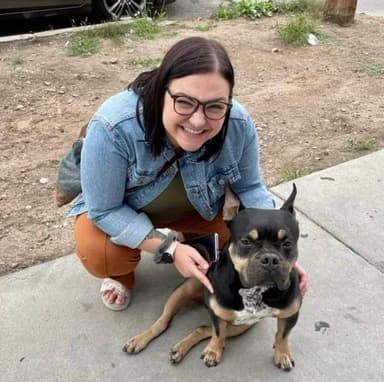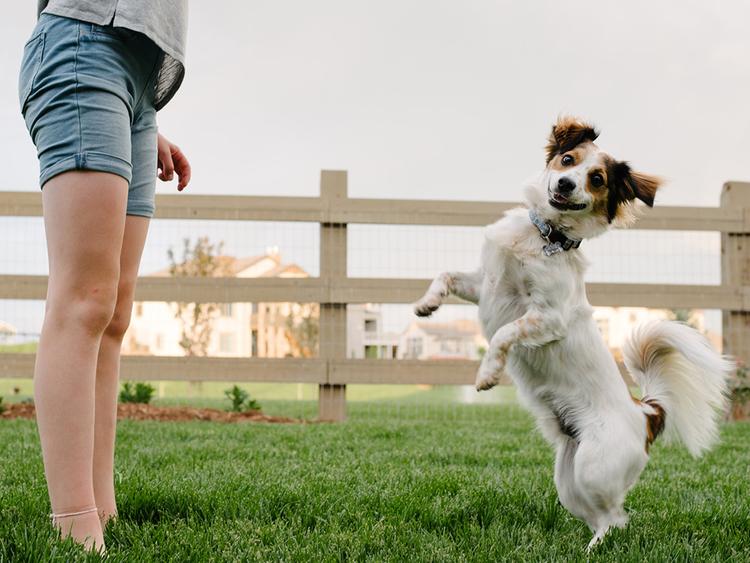Adopting a Tripod Dog: What You Need to Know and How to Care for Them
Experts shed light on what life’s like with a three-legged dog. Spoiler alert: They’re pretty awesome.
Experts shed light on what life’s like with a three-legged dog. Spoiler alert: They’re pretty awesome.
by Mollie Jackman, | April 3, 2025

RyleeAWalker / Shutterstock
When you adopt a tripod dog, you get one of the most resilient pets around. These pups adapt remarkably well on three legs and can be just as active and loving as their four-legged friends. While they may face unique challenges such as mobility adjustments, they can lead comfortable and fulfilling lives.
As a pet parent, you’ll learn the keys to a tripod dog’s well-being, like providing a safe home environment, managing their exercise routine, and understanding their long-term health needs. This guide covers everything you need to know about adopting and caring for a three-legged dog, debunking misconceptions, and offering practical tips to help them thrive.
TL;DR: Tripod dogs can live happy, active lives with proper care. Understanding their mobility, health, and emotional needs will help you decide if adoption is right for you.
Adopting any dog is a big decision, and understanding the unique needs of a tripod can help you determine if you’re ready to adopt. While three-legged dogs are incredibly adaptable, they require special attention in areas such as mobility support, joint health, and injury prevention. Knowing how they compensate for a missing limb and which adjustments may be necessary will help you determine if you should adopt a tripod dog.
Dogs adjust quickly to life with three legs, instinctively shifting their weight to maintain balance. Most can run, jump, and play just like any other dog, often unaware of their differences. While some three-legged pups need guidance at first, maintaining a healthy weight, incorporating low-impact exercises (such as swimming or short walks), and consulting a canine rehab therapist can help.
“There’s a perception that tripods can do anything, and they really can because that’s the nature of dogs. However, it’s our responsibility as pet parents to help prevent injury,” says Renee Agredano, founder of the Tripawds Foundation. She strongly recommends rehab therapy, noting that even a single session can be highly educational. To support this, Tripawds Foundation offers reimbursement for an initial consultation, helping pet parents set up their dogs for success.
Not all tripod dogs adapt at the same pace. Factors such as age and breed play a significant role in how quickly and easily they adjust to life on three legs. While some dogs bounce back within days, others require more time and support to regain their confidence and mobility.
Potential adaptability is based on your dog’s age group.
Young dogs and puppies: They adjust quickly as they are still developing coordination and muscle strength.
Adult dogs: It may take adult dogs longer to adapt, but they usually regain confidence within weeks.
Senior dogs: Older dogs face more challenges due to joint issues, arthritis, or decreased muscle tone. They require extra support like ramps and pain management.
Adaptability is based on your dog’s size/shape.
Small and medium breeds: These dogs adapt more easily due to lower body weight. They can continue running and playing with minimal difficulty.
Large breeds: Bigger dogs experience more strain on their remaining limbs, requiring careful weight management and joint care. Some of these pups may benefit from mobility aids.
Long-backed breeds: Their body structure will put extra strain on their spines, making injury prevention and movement support essential.
How a dog loses their limb affects the ways they adapt to life without it, as well as the care they require.
Severe trauma: A dog who loses a limb in a car accident, fall, or due to other serious injury may take longer to adjust, especially if they were previously active. They might experience phantom pain or need time to rebuild strength and balance.
Cancer or severe infections: Osteosarcoma, a common cancer in dogs that affects their bones, and life-threatening infections that don’t respond to treatment can both lead to amputation. Monitoring the health of these already sick pups and ensuring they still have good qualities of life are the biggest priorities.
Congenital conditions or birth defects: Some dogs are simply born with missing or malformed limbs. These pups often don’t need to adapt — they’ve never known anything different. They tend to develop their own way of moving and thriving.

valeriyap / Adobe Stock
Caring for a three-legged dog comes with unique, but not impossible, responsibilities. The most important factor isn’t the number of legs your dog has — it’s the kind of pet parent you are. Tripod dogs don’t see themselves as different, but they do rely on their humans to provide safe, supportive, and accommodating environments. If you’re patient, proactive, and willing to make small adjustments to your lifestyle, a three-legged dog can be an amazing companion. It isn’t hard to care for a three-legged dog, but there are some requirements:
Tripod dogs may not always show you that they’re struggling. Because dogs are naturally resilient, they will often push through discomfort to keep up with their families. A good pet parent for a three-legged dog pays close attention to subtle signs of fatigue, discomfort, or difficulty moving and makes necessary adjustments — whether that means shortening a walk, providing a soft resting spot, or finding the right vet for your tripod.
Whether you’re adopting a blind dog, a pup with hearing impairment, or a tripod, most pups with disabilities won’t require complete home remodels. But they do benefit from minor modifications. Being willing to add rugs on slippery floors, using a harness for stability, or providing a comfortable orthopedic bed can greatly improve a tripod dog’s quality of life. A little extra effort goes a long way in preventing falls and unnecessary strain.
Routine vet visits are essential to monitor joint health, weight, and any early signs of strain. A tripod dog parent should be proactive about preventative care, including vaccinations, dental health, and discussions about joint supplements or physical therapy. Having a trusted vet who understands tripod dog needs can make a big difference. You may even be able to find financial assistance for vet visits.
Tripod dogs thrive when pet parents approach their care with confidence, patience, and encouragement. Celebrating small victories — such as mastering stairs or running freely — helps build their independence and trust. Providing consistent support, a positive attitude, and a loving environment allows them to embrace life fully. With compassion and flexibility, a tripod dog will reward you with unwavering loyalty and resilience.
What goes into taking care of a tripod pup? Here are a few more helpful tips.
Tripod dogs don’t need major home changes, but traction is key, says Renee Agredano, founder of Tripawds, an online community for parents of three-legged dogs.
Here are some simple ways to prevent slips.
Use rugs with plastic backing on hardwood floors.
Place traction tape on stairs.
Get some pet steps for beds and couches.
Use baby gates to block stairs if needed.
Tripods can use stairs, but Agredano notes, “Front-legged tripods have a harder time going down, and the opposite is true for rear-legged tripods.” A harness with a back handle provides extra support and reduces joint strain.
Exercise is vital for all dogs, regardless of how many legs they have. For tripod dogs, a balanced routine (no pun intended) helps maintain strength, mobility, and overall health while preventing strain on their remaining limbs. Low-impact activities such as walking on soft surfaces, swimming, and gentle play are ideal. Short, frequent walks tend to be better than long outings, and it’s important for tripod parents to recognize signs of fatigue. Gentle stretching and physical therapy further support joint health and long-term mobility.
Get ahead of orthopedic care through diet and supplements. Tripods are at risk of orthopedic injuries and developing early onset osteoarthritis because their working legs are picking up the slack for the missing fourth. Ask your vet if a special diet containing fish oil could be beneficial, or if adding a supplement with glucosamine and chondroitin could help your dog. Although supplements may be an added expense, they can help pet parents save money by preventing issues in the future.
“What’s even more important is that a tripod dog maintains a lean body weight,” says Dr. Samantha Palermo, a relief veterinarian and partner at Evette. Studies show that maintaining a dog’s ideal body weight reduces the onset of joint disease and extends the life of the pet. It can also reduce the likelihood of common orthopedic injuries in tripods, such as cruciate tears (similar to ACL tears in humans).
For many tripod dogs, especially those who have lost a limb due to injury or trauma, positive reinforcement is key to rebuilding confidence and trust. Gentle, reward-based training helps them feel secure in their new body and environment, reinforcing that they are safe and capable. Praising their progress — whether mastering the stairs, navigating new surfaces, or regaining balance — with praise, treats, and affection can make a huge difference in their emotional well-being. Avoiding punishment is especially important, as these dogs may already have anxiety linked to past experiences. By creating a patient, encouraging environment, pet parents can help their tripod dogs not just adapt, but truly thrive.
Pet insurance is beneficial when it comes to covering unexpected illnesses, injuries, and, depending on your plan, routine care. However, orthopedic disease and injury may not be covered under certain plans for tripods, because they may be categorized as preexisting conditions.
Ask the insurance provider for a medical records review. “They can tell you what will be covered and what will be preexisting,” Agredano says. Another option is to consider an insurance plan that covers preexisting conditions, such as AKC Pet Insurance. This plan requires a one-year waiting period.
Although social media often shows tripod dogs using wheelchairs, not all of these pups need expensive equipment. A canine rehab therapist can help determine the right support.
Harnesses: Front-leg amputees may struggle with slipping harnesses, but Ruffwear’s Flagline Harness is a great option. “It tends to slip the least,” says Agredano, and its back safety handle is recommended by Dr. Palermo.
Toe grips: For dogs who struggle on slippery floors, Dr. Buzby’s Toe Grips provide extra traction. “They go around a dog’s nail like a rubber band and add traction,” Agredano explains.
Assistive devices: Wheelchairs and prosthetics can help, but consult a vet or rehab therapist before investing.
Dog strollers: For dogs who tire easily, strollers offer a way to rest while staying active. In multi-dog homes, they help tripods keep up with their four-legged friends. “A four-legged dog is always going to want to go longer than a three-legged dog, and the three-legged dog is always going to want to keep up,” Agredano notes.
Not every tripod dog needs extra gear, but the right tools can improve their mobility and comfort when necessary.
While tripod dogs can lead full and active lives, adopting a three-legged pup can require some adjustments. The good news? Most of these challenges can be easily managed with the right care and preparation. Below are some common concerns and practical ways to help your three-legged pup thrive.
Hardwood floors, tile, and stairs can be challenging for a three-legged dog, especially right after amputation. Adding traction is one of the simplest ways to prevent slips and falls. Area rugs with non-slip backing, yoga mats, and pet-safe traction stickers can improve stability. For stairs, installing a baby gate to prevent unsupervised climbing and using a supportive harness with a handle can help guide your dog safely up and down them.
Tripod dogs often want to keep up with their four-legged companions, but they may get tired more quickly. Pay attention to their energy levels, and allow breaks during play to help them stay safe and healthy. A pet stroller or wagon can be a great investment for outings, allowing your dog to enjoy long walks without overexerting themselves.
Some people may stare or ask questions about your dog’s missing limb, but tripod dogs don’t see themselves as different. Confidence is key to their well-being, and with positive reinforcement, they can be just as self-assured and social as any other dog. Encouraging interaction, offering praise, and rewarding them with treats helps build their confidence and independence. With a little extra care and attention, tripod dogs thrive — often with an inspiring zest for life.
Lastly, when you adopt a three-legged dog, remember the 3-3-3 Rule. With any adopted dog, it’s normal for them to decompress within three days, learn their new routine in three weeks, and fully settle in within three months. This may take a bit longer for tripod dogs, because they’re working with their own unique challenges.

Soi Dog Foundation / Arandy
Adopting a tripod dog can be a wonderful experience, but it’s important to consider if their needs align with your lifestyle. Ask yourself the following questions to determine if you’re ready to provide the best home for a three-legged companion.
Would a tripod dog be a great companion for me? Tripod dogs are loving, playful, and resilient — perfect for those seeking an inspiring, affectionate pet.
Am I okay with making small adjustments to my home and routine? Minor changes like adding rugs for traction, ramps, or a harness can make life easier for a tripod dog.
Am I prepared for more frequent vet visits or potential medications? Joint strain and arthritis are common for tripods, so you may want to set aside a budget for extra vet visits and supplements.
Am I comfortable answering questions from curious people? Be ready to educate others about your dog’s ability to live a happy, active life.
Can I take precautions to reduce the risk of injury? Providing a safe environment and monitoring activity helps prevent slips, falls, and overexertion.
If you answered “yes” to most of these questions, get ready to start the pet adoption paperwork. With love, patience, and the right care, these dogs will thrive and bring endless joy to your life. You may even find a dog to adopt right here on Adopt a Pet.
Yes, tripod dogs are incredibly resilient and can live happy, active lives with the right care. They adapt quickly to their new way of moving and can enjoy running, playing, and bonding with their families just like any other dog. While they may need some adjustments, their quality of life is just as high.
Not all tripod dogs require ongoing medical care, but they are at a higher risk for joint strain and arthritis due to increased pressure on their remaining limbs. Regular vet checkups, weight management, and joint supplements can help keep them healthy. Some dogs may benefit from physical therapy or mobility aids, especially as they age.
To support a tripod dog’s mobility, provide traction on slippery surfaces, use ramps or pet steps for high places, and engage in low-impact exercise like swimming or controlled walks. A harness with a handle can offer extra stability when needed, and regular muscle-strengthening activities can help prevent overuse injuries.
Yes, most three-legged dogs can run, jump, and play just as well as their four-legged counterparts. However, they may wear out more quickly or need more frequent breaks. Monitoring their energy levels and avoiding overly strenuous activities can help prevent strain or injury.
While caring for a tripod dog comes with unique considerations, it’s not necessarily more difficult. They may require some adjustments, like joint care and slight home modifications, but their adaptability and enthusiasm make them just as loving and rewarding as adopting any other pet. With the right support, they thrive and live full, active lives.
“CSU Gait Study Examines the Tripawd Dog Hop.” Tripawds, 12 Nov. 2014, tripawds.com/2014/11/12/csu-gait-study-examines-the-tripawd-dog-hop.
Digital, MedVet. “What Happens When Your Pet Needs an Amputation?” MedVet, 31 Jan. 2022, www.medvet.com/amputation.
“It Makes No Sense to Punish a Fearful Dog.” Psychology Today, 2025, www.psychologytoday.com/us/blog/decoding-your-pet/201412/it-makes-no-sense-to-punish-a-fearful-dog.
PhD, Todd. “Positive Reinforcement and Dog Training VII: Summary and Conclusions.” Companion Animal Psychology, Blogger, 15 Aug. 2012, www.companionanimalpsychology.com/2012/08/positive-reinforcement-and-dog-training.html.

Mollie Jackman is a writer, editor, and graduate of Lindenwood University’s MFA in writing. She’s also a pet parent to a goofy big-eared dog and two brown tabby cats, plus a rotating cast of foster animals. When she’s not reading, writing, or picking up strays, she can be found binge-watching arguably terrible reality TV shows and cooking competitions or rolling around the local skating rink in Columbia, Missouri.

Adoption Advice

Adoption Advice

Adoption Advice

Adoption Advice
Short answer: Absolutely. After a little preparation, you’ll find immense ease and satisfaction in opening your home to a sight-impaired pup.

Adoption Advice
Is the responsibility of taking care of your pet causing you to worry about your budget? Rest assured, there are a number of ways to minimize this financial stress.

Adoption Advice
Dealing with high vet bills? See assistance options for affordable pet care. Get the support your pet needs without breaking the bank.

Adoption Advice
Learn more about how you can find a dog shelter that meets your expectations.

Adoption Advice
Did you adopt an old soul? These cute old lady dog names are perfect for your pup and will make them feel like a part of the Golden Girls pack.

Adoption Advice
Find out how to set your adopted rescue dog up for success.

Adoption Advice
Pet parenthood can be tough, but finding the right vet doesn’t need to be. These tips will help you find the right vet for your pup.

Adoption Advice
Wondering about tax savings for pet expenses? Learn about pet tax deductions to understand how to claim your pet on taxes.

Adoption Advice
Are you finalizing a new pet’s adoption? Learn everything you need to know about pet adoption paperwork.